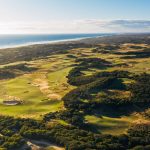
By Val Latimer – Mornington Peninsula Family History Society
In the early days of settlement in Melbourne, public baths were a popular means of keeping clean. In the 1840’s there were several public baths along the Yarra River. Bathing in the sea was an alternative to bathing in a river. The problem with sea bathing was that bathing in public view from sunrise to sunset was forbidden.
Early ventures
On 3 November, 1843 The Melbourne Times reported:
FLOATING BATHS
The Council having heard that His Honor had granted permission to Mr. Palmer to erect floating baths above the falls, His Worship the Mayor had been requested to enter into correspondence with His Honor upon the subject, and to point out to him the extreme impolicy of such a step, the Town of Melbourne being supplied with water from the particular spot upon which the erection of floating baths was contemplated.
His Honor in reply stated, that he had not granted any particular spot for the purpose, but had merely suggested that immediately below the basin would be the most eligible situation.
This item was followed up eleven days later, again in The Melbourne Times:
FLOATING BATH
A Floating Bath is in the course of erection, we believe, by Dr. Palmer; whilst we admit the utility of baths for the preservation of the health of the inhabitants, we would draw the attention of the projector to the selection of a judicious spot; to allow the floating bath to remain in its present spot would be a great eye-sore.
An item in The Port Phillip Gazette on 13 January, 1844 reported that Mr. Riddle of Collins Street had great pleasure in announcing that a new Bathing Establishment had been erected on the south side of the Yarra, nearly opposite the Customs House, and consisted of an oblong apartment divided into two by a substantial partition.
One bath was for the respectable portion of the community who brought their own towels, &c.; the other was for those who chose not to be at that trouble. Mr. Riddle also went to considerable trouble to construct a boat punt above the falls, where he would give passage gratis to those who frequented his baths.
Dr. Palmer wasn’t having much luck. The Port Phillip Gazette reported on 29 May, 1844:
PALMER’S BATHS
These baths ‘ere long will be non est inventus. The whole of the roof, and a considerable portion of the planks have been swept away; and the present current will, in all probability, sweep away the frame stakes. This gentleman is certainly very unsuccessful in his maritime specs, and his recent disaster on terra firma, by the destruction of valuable property at his premises in Flinders-street, caused by the flood, has added, in no small degree, to the catalogue of his misfortunes.
The last mention of the fate of Dr. Palmer’s baths appeared in The Port Phillip Gazette on 5 April, 1847:
THE SWIMMING BATHS
We have observed during the last two or three weeks that the Swimming Baths across the Yarra have been turned into a regular scene of riot and mischief. The whole of the urchins of Melbourne are congregated there, and the work of destruction is frightful. They are tearing off the roof, knocking in the planks, and doing every kind of mischief. What are the police about?
And on 24 August, 1847 readers of The Port Phillip Gazette were advised of the fate of Mr. Riddle’s swimming bath:
NOVEL SCHEME
Most of our readers will remember that Mr. T. C. Riddle erected a swimming bath on the South side of the Yarra, which we regret to say did not prove a very profitable speculation. Some ingenious person has purchased this place, and has turned it into a warehouse for washing wool. This place is peculiarly adapted for this purpose, and will pay much better than it has ever done hitherto as a bathing house.
Then on 10 December, 1859 an advertisement for Kenney’s Bathing Ship appeared in the Melbourne Argus:

Captain William Kenney had purchased the condemned Scandinavian ship “Nancy” in 1854, and beached her at St. Kilda. Bathers were taken out to the ship by dinghy and a shoreline. The following year he erected a fenced-in enclosure. This proved popular to those who enjoyed sea bathing, but were afraid to bathe in the open sea because of sharks.
William Kenney managed to keep his Bathing Ship viable throughout the coming years with continual maintenance necessary due to storms and gales. The Argus of 10 August, 1876 printed this letter to the Editor:
INSECURE BATHS AT ST. KILDA
Sir, – I shall feel obliged if you will let me, through your column, direct attention to the disgraceful state of Captain Kenney’s St. Kilda Baths. During a storm in February, or early in March last, large breaches were made in the fence, and to this day, these breaches remain unrepaired. A few posts, it is true, have been erected, and there the matter stands. Bathers must either risk the sharks or not go at all.
I may be reminded that there are other baths in St. Kilda besides Kenney’s, but I hold a season ticket for Kenney’s, and in addition, they are more convenient for me to go to than any other.
Surely, if Kenney monopolises the best site in St. Kilda for a bathing establishment, he ought to afford proper accommodation. If he won’t do so, let his lease be cancelled, and the position given to a more enterprising man.
By publishing this grievance, you will do a favour to a number of gentlemen, and also make Mr. Kenney a little smarter in his movements.
Yours, &c., TIMOTHY

William Kenney’s responded the following day in The Argus:
KENNEY’S BATHS At St. KILDA TO THE EDITOR OF THE ARGUS
Sir, – “Timothy” in to-day’s issue has called attention to what he is pleased to term the disgraceful state of my baths.
Allow me in reply to inform the public that owing to the natural growth of mussels and seaweed on the piles at my baths, some of them have been carried away in the violent gales prevalent during the past few months.
To repair this damage I have a gang of men employed under my own superintendence pole-driving, which is, I may tell “Timothy”, not only an expensive but also a very slow job.
It is, however, progressing satisfactorily, and within 14 days from this every part of the fence will be tight and ship-shape.
Trusting this will allay any public anxiety, and be sufficient to soothe “Timothy’s” agony for the safety of his shins,
I am, etc. WILLIAM KENNEY, Esplanade, St. Kilda.
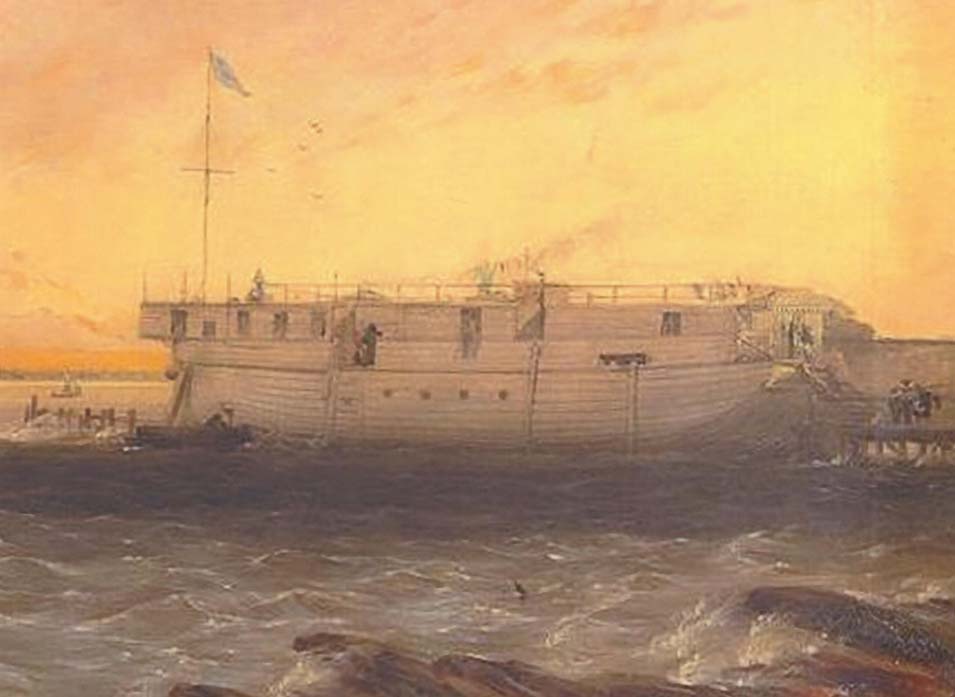
By 1909 Kenney’s Baths’ days were numbered. The St. Kilda Foreshore Committee and St. Kilda Council had plans for improvements along the sea front that did not include the Baths.
In July 1909 the Premier and the Minister for Lands invited representatives of the St. Kilda Council, the St. Kilda Shore Committee and Mr. Kenney to meet them in conference at the Lands Department to discuss the question of the removal of Kenney’s Baths, in order that the proposed extensive improvements could be carried out.
The lease for the baths expired the previous December and had not been renewed by the Lands Department.
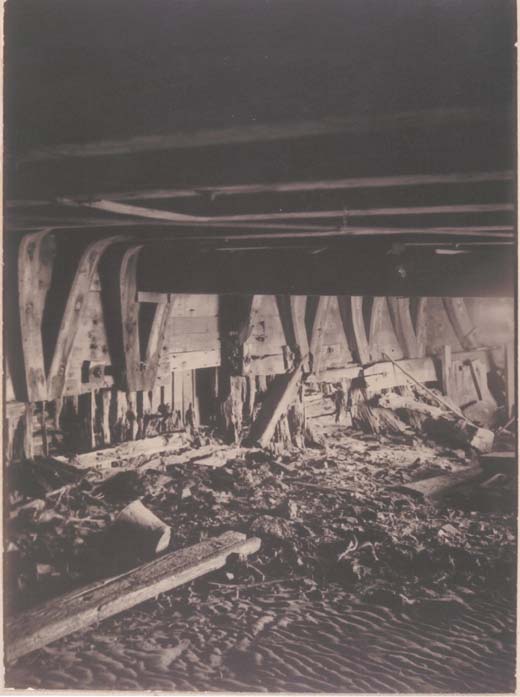
In June 1912 the Melbourne Leader reported the “gradual disappearance of perhaps one of the most interesting of Melbourne’s relics – Kenney’s ‘Old Ship’ baths at St. Kilda.”
By the 1870’s sea baths had been established in Sandridge, Williamstown, Brighton, St. Kilda and Emerald Hill. A sea bath is a protective enclosure for sea bathing. The swimming area in the 1800’s was enclosed with water-resistant stakes, so that a large canvas could be stretched around the enclosure, such as Sandringham Sea Baths in 1895. Throughout the nineteenth century there were as many as six different sea baths operating along the St. Kilda shoreline. The most prominent of these, with its cluster of domes, would not have looked out of place at English resorts such as Blackpool or Brighton.
Young’s Baths at Frankston
In May 1883 it was reported in The South Bourke and Mornington Journal that an enterprising townsman in Frankston was going to have public baths erected. By December of 1883 that ‘enterprising townsman’, Mark Young, owner of the Pier Hotel Frankston, had placed an advertisement in The Argus advertising his Pier Hotel and the Sea Baths:
PIER HOTEL, Frankston. Possessing every convenience for Families and visitors. Picnics catered for. Special accommodation for bridal parties. Shower and plunge baths of sea or fresh water. Enclosed sea baths. Books, billiards, lawn tennis. Saddle and buggy horses for hire. MARK YOUNG
Mark Young constructed his enclosed sea baths on a bed of granite, located roughly 100 metres off the coastline of Frankston Beach, at a cost of £950. The Sea Baths were connected to the coastline by a wooden pathway that led to a suspension bridge over Kananook Creek to Young’s Pier Hotel.
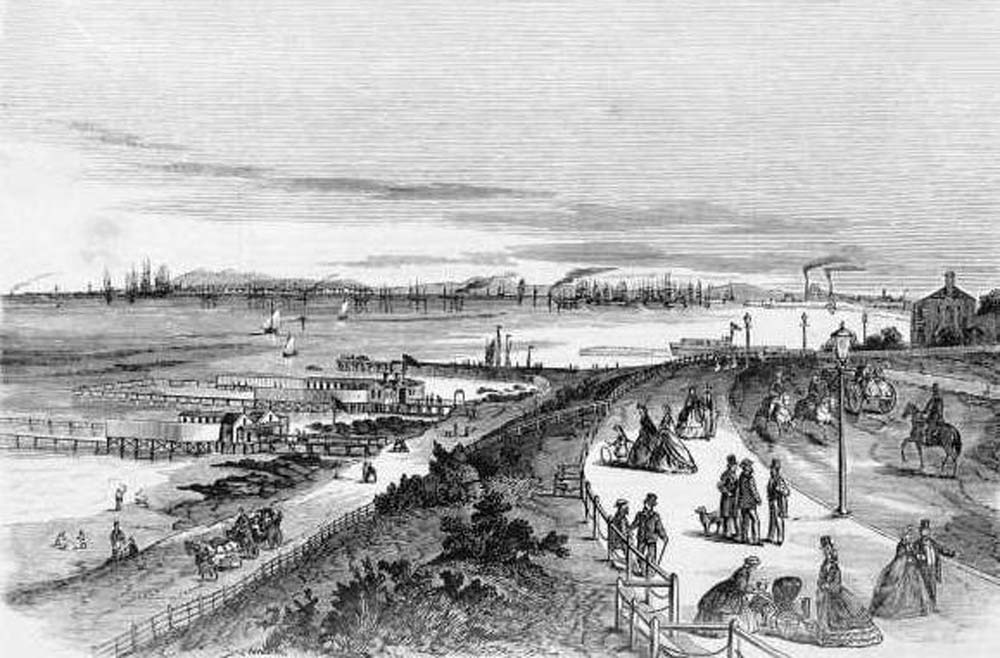
Corporation Baths
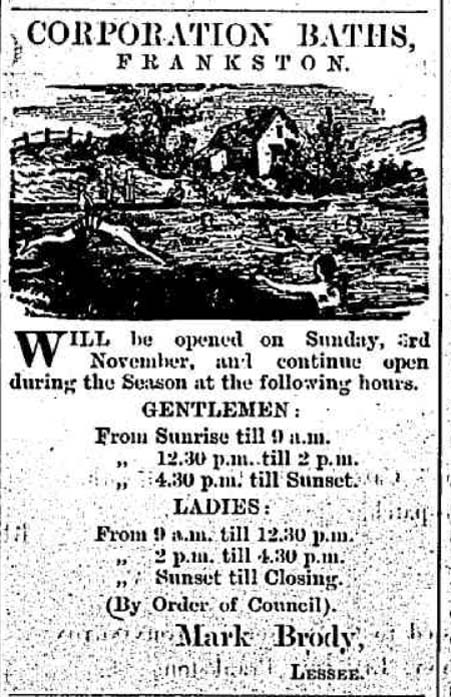 Mr. Young must have found that operating his Sea Baths was not very profitable, because by October 1888 he had sold the baths to the Shire Council. He sent them a letter pointing out that as they were now the owner of the baths, they were responsible for the Government fee for baths.
Mr. Young must have found that operating his Sea Baths was not very profitable, because by October 1888 he had sold the baths to the Shire Council. He sent them a letter pointing out that as they were now the owner of the baths, they were responsible for the Government fee for baths.
After much discussion at the Council meeting in October 1888 it was decided to call for tenders for the position of Caretaker of the Frankston Corporation Baths, preferably a husband and wife. It was also decided that a cottage would need to be erected for the caretaker.
Then on 2 November, 1889 The Mornington Standard alerted its readers: “By advertisement it will be noticed that the Frankston Corporation Baths are to be opened to bathers from tomorrow morning. The hours when they will be opened to ladies and gentlemen are given in the advertisement”.
Failing to find a husband and wife team the Council appointed Mr. Droyd as caretaker, but after he had spent £10 on the maintenance of the Corporation Baths, he sent a letter in October 1889 to the Council asking “to be dealt fairly in the matter”.
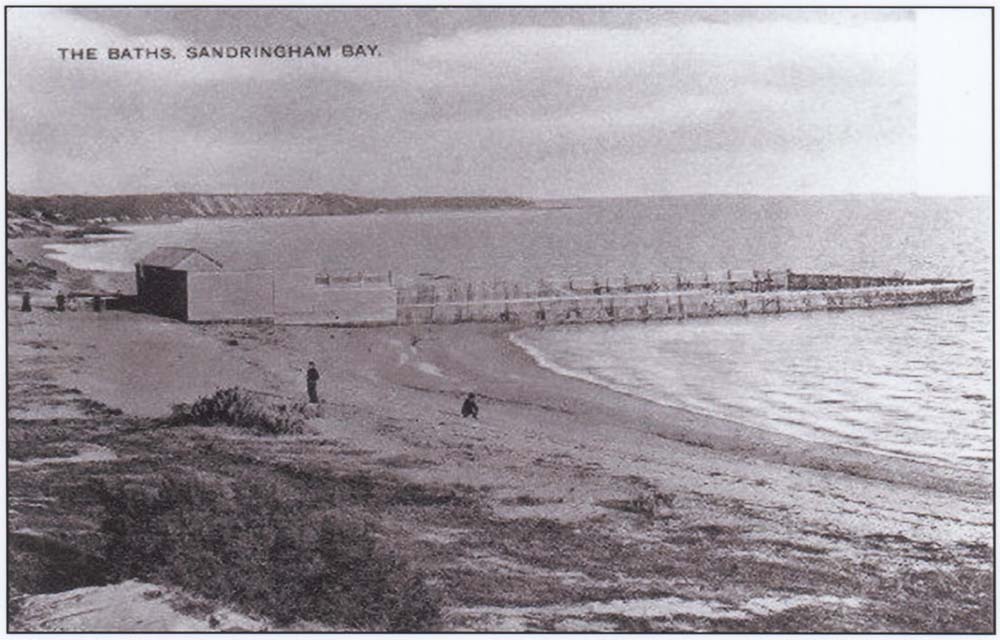
As lessee of the baths he had taken the position on the understanding that he should have a cottage on the shore.
At the Council’s October meeting Cr. Souter was astonished that the Lands Department had refused their application, stating that there shall be no building erected on the foreshore.
Cr. Souter did not dispute the right of the department to refuse the application, but he said “the Minister of Lands is only a creature of the day, and has treated us in a very undignified manner.”
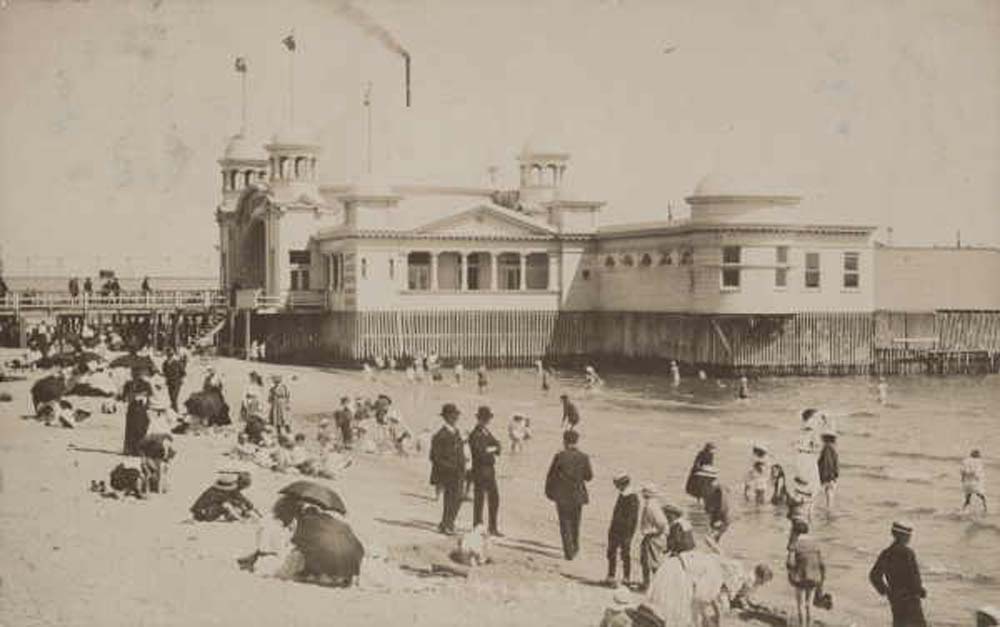
One month later a new lessee (Mark Brody) had been appointed, with an advertisement appearing in The Mornington Standard in November 1889 for the Frankston Corporation Baths.
Mark Brody managed the Corporation Baths until November 1892, when he wrote to the Council regretting his inability to pay the rent owing, and placing himself in the hands of the Council. The baths were also in need of repair and maintenance, as each year storms caused considerable damage. Mr. H. Fuller offered to put the baths in repair if given rent free. The Council accepted his offer and moved that he should have the baths for two years free of rent.
Frankston Baths
By December Mr. Fuller had opened the Frankston Baths, advertising in The Mornington Standard:
“H. Fuller begs to notify to the public that he has taken over the Frankston Baths, and trusts by strict attention to business to receive the patronage of the public.”
In February 1894, several ladies were in bathing, one of whom went beyond her depth, and being unable to swim, was in great danger of drowning. The only bather in the group who could swim, rushed to her rescue, but was soon in danger herself and had to attend to her own safety.
Mr. H. Fuller, the lessee of the baths, was quick to respond. He threw off his coat and vest and plunged into the water, saving the lady from drowning.
Once again fierce storms were causing continual damage to the baths and in May 1895 the Shire of Frankston and Hastings advertised in The Mornington Standard for tenders to collect and stack the stakes in the Frankston Baths.
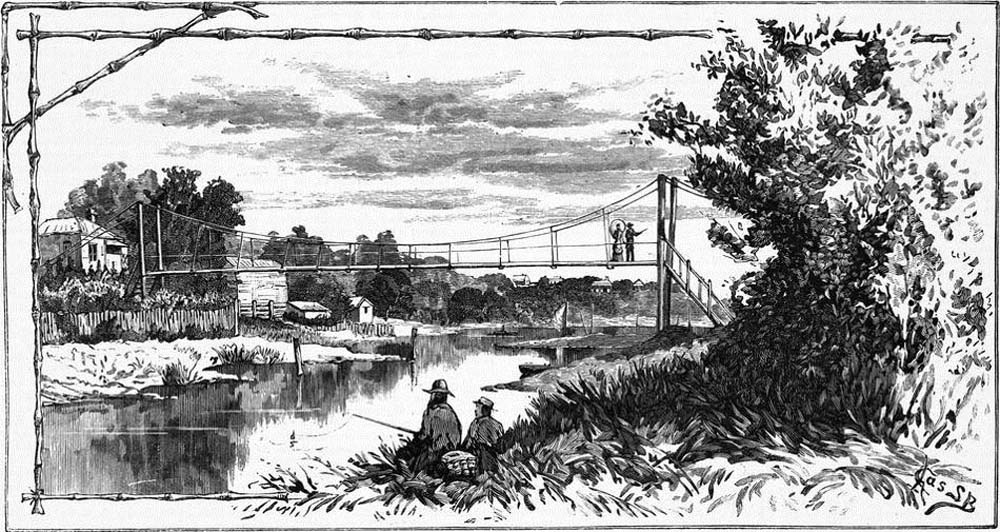
Shire of Frankston and Hastings
TENDERS – Will be received up to 1.30 p.m. on FRIDAY, 7th JUNE, 1895, at the Mechanics’ Institute, Frankston, for TAKING UP and STACKING the STAKES in the Frankston Baths.
Specifications to be seen at Mr. S. Sherlock’s store, Frankston.
The lowest of any tender not necessarily accepted.
HENRY E. MOORE, May 29, 1895.
Shire Secretary.
Mr. A. Bentick’s tender was accepted, he being the only tender lodged, but by August 1895 he stated he was unable to complete his contract at the Frankston Baths, as it was impossible to withdraw the stakes. The contract was cancelled and the Council moved that no further action be taken until they decided what to do with the baths.
Frankston Baths Committee
In August 1896 a public meeting was held in the Mechanics’ Institute, Frankston, to discuss the best course to be adopted in regard to the Frankston Baths. Ex Cr. Mark Young was adamant that the baths should not be abandoned.
“Without baths in Frankston one and all would suffer severely. We depend on people from outside. We have only to look at the papers to see how the other places are catering for the people. Even at Hastings they are trying to get baths in order to cater for the public and they have not a tenth of the advantages that we have.”
He moved that they have a committee of nine, with power to add to their number to devise means for carrying on the baths. This was seconded and carried. Dr. Sidney Plowman was the convenor.
In October 1896 another Public Meeting was announced by Dr. Plowman. This time it was to consider the question of securing the ship “Hilaria”, fitted up as a Floating Bathing Ship instead of repairing the existing baths.
At this meeting it was decided not to proceed any further in bringing the ship “Hilaria” to Frankston, mainly for two reasons. One being that the gentleman who made the offer to the shareholders in the syndicate was not present, and the other was that the ship would not be brought there before December.
Mark Young did not want to see the Frankston Baths remain in such a dilapidated state and in September 1897 offered to make the repairs to the baths, and they were re-opened in December of that year. The Mornington Standard in their “Brevities” column made mention: “Nude bathing at Frankston prohibited. Frankston baths re-opened. Red flag gentlemen, white flag ladies.”
Frankston Baths Destroyed
But, not for long. The Mornington Standard on Thursday 3 November 1898 reported:
“The highest sea for years was running in the bay on Friday night and the Frankston baths suffered somewhat, the beach for a considerable distance being strewn with the debris.”
After the destruction of the baths there was no further effort to repair the damage and re-open them to the public.
It was now time for Frankston to move into Open Sea Bathing. The following item appeared in the Melbourne Herald on 17 October, 1908:
OPEN SEA BATHING. THE SUBURBAN FORESHORE. WHAT IS PERMITTED
With the sudden accession of the hot weather the question of open sea bathing has rapidly sprung to the front. Legislation is threatened by the municipal bodies to deal with the question of mixed bathing. As a consequence, inquiries are constantly and naturally made as to the places and conditions under which bathing is at the present time permitted. Some information on the subject will therefore be seasonable.
FRANKSTON – At Frankston open sea bathing and mixed bathing are allowed, providing that the bathers are properly clad and keep “a reasonable distance” from the pier.
There were formerly public baths at Frankston, but these were swept away in a heavy storm.
Val Latimer is a researcher from Mornington Peninsula Family History Society. The Society would welcome enquiries from prospective members. Its clubrooms are located at the Frankston Southern Recreation Centre and are open Tuesdays and Thursdays (10.30 a.m. to 2.30 p.m.) and Sundays (2 p.m. to 5 p.m.).
Further information can be obtained by calling (03) 9783 7058 or emailing editor@mpfhs.org




